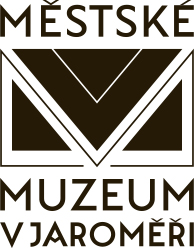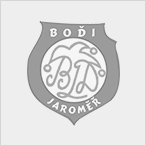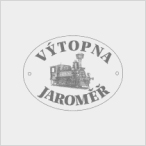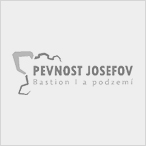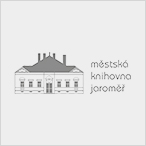Jaroměř Town Museum
was established in 1883. Since 1947 its residence has been the premises of Wenke’s House at Husova 295, Jaroměř
Originally a department store run by A. Wenke & Son, the building of the Town Museum was constructed in 1910-1911 as a design of the renowned architect Josef Gočár. A listed building, it remains one of the great and notable monuments of modern European architecture.
Wenke House: an architectural jewel from the beginnings
of the Czech Modern Style
The significance of Wenke House in Jaroměř as shown in the context of architectural works of Josef Gočár.
A renowned architect and one of Kotěra’s disciples, Josef Gočár (1880-1945) was one of the key figures of Czech architecture in the early twentieth century – he was also the chairman of the Mánes Association of Fine Arts and a professor at the Academy of Fine Arts, Prague. His work underwent complex evolution – from Art Nouveau and Modern Style, through Cubism and so-called National Style, to avant-garde architecture of Constructivism and Functionalism. By far the greatest interest of modern scholars revolves around Gočár’s cubist designs and implementations, followed by his interwar work. However, his designs from a relatively short period of 1908-1910, before his inclination to Cubism, are still – needless to say, undeservedly – rather marginalized. Yet, it was during this very period when the young designer managed to push through several structures, which were ahead of their own time by many years.
This grouping of Gočár’s works primarily includes two projects – Luther House in Hradec Králové and the design of a sanatorium in the Prague neighbourhood of Podolí, submitted in a tender – and three implementations – of a concrete stairway rising to the Church of Our Lady in Hradec Králové, Jarušek House in Brno and Wenke House in Jaroměř. This exceptional series followed immediately after Gočár’s leaving of the design studio of Jan Kotěra, his teacher, where he had worked after his graduation at the School of Applied Arts in Prague and had already shown his talent and worth (in collaboration with Kotěra, Pavel Janák and Jan Štursa, one of the founding fathers of modern Czech sculpture) in the remarkable design of the pavilion for the Jubilee Exhibition of the Chamber of Trade and Commerce, held on the exhibition grounds in Prague in 1908. The framework of this spacious wooden U-shaped structure was still made of wood, but the front was already dealt with in distinctive ascetic Modern Style. More independent projects followed and the young designer made excellent use of new construction materials, such as steel and reinforced concrete. The simply elegant studies of Luther House in Hradec Králové and the Protopurist sanatorium in Podolí, which might have been influenced by the works of Adolf Loos’s circle, were not implemented in the end – but, luckily, other constructions were. The new monumental stairway in Hradec Králové took full advantage of the possibilities provided by reinforced concrete, the asceticism of the whole construction being refined by means of a steel lamp motif, hung up in the space of the arch framing the view of the landscape. A detailed look at Jarušek House in Brno (after recent – unfortunately, rather insensitive – renovation) reveals the influence of Josef Hoffmann. The four large arched oriel windows, supported by a pair of slender columns, evoke a sense of true originality. The upper part of the front ends with a noticeable cornice. The front of Wenke House can be seen as a variation of the same theme, with the special addition of a ribbon window at the level of the second floor. The function of this motif, borrowed from American and Parisian department stores, is not dictated only by practical reasons. The seemingly fragile lower part of the front stands in interesting contrast to the upper part, ending with the same kind of noticeable cornice as mentioned before. Below the cornice there is a row of windows of the upper floor, divided by grooved black columns. The interior plan, with its optical interconnection of the ground floor and second floor through a central circular opening, is also worth noticing and speaks of the designer’s mastery. Moreover, Gočár decided to use a whole series of simple features, including glass blocks. The decoration is reminiscent of Hoffmann again.
None of the other Gočár’s constructions managed to achieve a similar effect. His series of studies of house fronts in a style close to the Dutch Neoplasticism is almost unknown. His design of steam mills in Pardubice still wants due appreciation. Gočár’s subsequent cubist episode brought a definite end to the succession of fragile looking buildings of the type of Jarušek House or Wenke House. Perhaps only the first one in the new series – the House of the Black Madonna in Prague (1911-1912) – does not feel as heavy and cumbersome, which might be explained by the fact that the first draft was not made under the influence of Cubism and essentially remained anchored in the Modern Style. Its sculpted, protruding, oblique features first appeared only during the construction, in the second version of the front in 1912.
Josef Gočár’s interwar works underwent another complex evolution – from the “National Style” of the Bank of the Legion (Legiobanka), through a “Dutch” period, represented by the house of the Agricultural Education (Zemědělská osvěta) located in the Prague neighbourhood of Vinohrady, schools in Hradec Králové, or the Czechoslovak pavilion in Paris in 1925, to a prudent but slightly cumbersome understanding of Functionalism (for example, his villas in Baba in the Prague neighbourhood of Dejvice). It is also for this reason why Gočár’s pre-cubist phase is so significant and deserves more of our attention.
The history of A. Wenke & Son in Jaroměř
The opening of the department store belonging to A. Wenke & Son in the spring of 1911 was a major event not just for the town but also for the company – until then a small family establishment. The company was founded by Albert Wenke, a native of Duszniki in Silesia, in 1872. In 1893 the business was moved from the original shop, situated near the square, to a newly built house on Husova Boulevard. The company produced and sold seashell decor items, decorative boxes, and also traded in haberdashery. The construction of the first wholesale store in Jaroměř, a new selling space based on modern conception, was carried out in 1910-1911 as a design of Josef Gočár, a rather obscure architect at that time. The investor and commissioner was Josef Wenke, Albert’s son. The wholesale and mail-order division of the company supplied retailers in the Austro-Hungarian monarchy, as well as engaging in overseas trade. In 1929, at the beginning of the Great Depression, Josef Wenke died and the ownership was passed on to Karel and Oldřich, his sons. In the 1930s they opened another shop in Jaroměř, followed by stores in Hradec Králové, Trutnov and Prague. However, keeping a prosperous wholesale was not easy and the brothers found it difficult to cope with their father’s legacy.
So eventually, in 1938, the District Court in Jaroměř decided to decree an auction of the company assets. The department store, together with an adjacent building used as the headquarters of the company, which also included the owner’s flat, was bought by the local Trade Savings Bank (Obchodní záložna). Three years later both buildings were acquired by Polický–Rieker Company. In the time of the Protectorate (1939-1945) they became the seat of a branch of a German company called Mix & Genest Berlin. All the interior equipment and furniture was removed; the decorative painting on the walls and ceiling was covered.
In 1945 the Foundation of National Renewal turned the building into a warehouse. In 1946 the ownership was transferred to the municipality of Jaroměř; on 29th August 1950 A. Wenke & Son was erased from the trade register. Since 1947 the former department store has been the residence of the Town Museum. There are temporary exhibitions on the ground floor and second floor; the third floor houses a gallery of famous natives of Jaroměř – the painter Josef Šíma, the medal maker and sculptor Otakar Španiel, and the sculptor Josef Wagner.
Permanent exhibition
Works of the designers Josef Šíma, Otakar Španiel and Josef Wagner
JOSEF ŠÍMA
Josef Šíma is one of the great figures of European painting in the twentieth century. He was born in Jaroměř in 1891 and his birth house can still be seen here. Šíma’s father taught drawing and painting at the local school for artisans, which was also attended by the painter František Kupka. After his graduation at the Academy in Prague, in Jan Preisler’s class, Šíma studied at the Technical University in Brno. In 1920 he left for France, where he decided to settle permanently. But he still kept in contact with his mother country and as one of the members of Devětsil Association he actively participated in the cultural life in Czechoslovakia. In 1927 Šíma and his poet friends founded an artist circle called Le Grand Jeu, his work evolving in the direction of an effort aimed at the capturing of universal integrity of the world and human life. Still, Šíma’s imaginary landscapes and mythological parables also speak the language of the painter’s memories of the region of his young years. A significant part of his work comprised the work of an illustrator. The paintings on display are on loan from the National Gallery in Prague. His early works come from the collections of the Town Museum in Jaroměř.
Josef Šíma died in Paris in 1971. The painter’s bust was made by academic sculptor Vlasta Prachatická; in 1992 it was installed in the town park, behind the school Šíma once attended.
OTAKAR ŠPANIEL
In 1881 Otakar Španiel was born as the oldest son in a family of pewterers – the trade had been in the family for generations. He studied at the academies in Prague and Vienna and was one of the pupils of Josef Václav Myslbek, a leading Czech sculptor. He went abroad on several study trips. In 1919 he was appointed a professor at the Academy of Fine Arts in Prague and later became its rector. Španiel is considered to be the founder of the Czechoslovak medal making school – he designed the first Czechoslovak coins and created a number of outstanding medals, plaques and reliefs. He was also one of the leading figures of Czech neoclassicist sculpture. His work comprises both memorial and portrait pieces. A great part of Španiel’s artistic legacy can be found on display in the Town Museum in Jaroměř. His famous Pieta can be seen in the local cemetery; the one-third models of his statue of Tomáš Garrigue Masaryk, the first Czechoslovak president, served as models for the statues in Pardubice, Prostějov and also in Prague. Unfortunately, it has not been yet possible to restore Španiel’s memorial of T.G.M. in Jaroměř (first removed by Nazis, then by communists).
Otakar Španiel died in Prague in 1955. His birth house was demolished in 1883; a plaque by the sculptor Milan Knobloch can be seen in the place where the house once stood.
JOSEF WAGNER
Josef Wagner was born in Jaroměř in 1901. A pupil of Jan Štursa, Otakar Španiel and Otto Gutfreund, he drew his life-long inspiration from Matthias Bernard Braun, the genius of baroque sculpture, continuing in the work of his ancestors – sculptors and stonemasons, whose artistic work can be traced across Eastern Bohemia – just like his two brothers, Antonín and Václav. Wagner is one of the leading figures of the baroque-inspired current in the Czech sculpture in the 1930s. For the same reason, it is no wonder he was also an outstanding restorer of old works of art. In 1945 he became a professor at the Academy of Applied Arts in Prague. The work of Josef Wagner adorns a number of galleries in this country and the Town Museum in Jaroměř is proud to be the owner of several Wagner’s smaller pieces.
Josef Wagner died in Havlíčkův Brod in 1957. Unfortunately, his birth house has not survived.
Historical exhibition in Josefov
The historical exhibition of the Town Museum in Jaroměř can be found on the third floor of the former Provisions Office of the fortress in Josefov (Riegrovo náměstí 8, Josefov), built in 1788. There are surviving ovens on the ground floor – which was restored and opened to public – where soldiers’ bread was baked. The storerooms were used to hold supplies of grain and other necessities needed by the garrison. The building served as a warehouse to store provisions even in the time of the First Republic (1918-1939). After WWII, until 1992, it was used by the military as an equipment depot.
The exhibition in the museum presents the region of Jaroměř in the prehistoric period and shows the historical development of Jaroměř – as one of the so-called “dowry towns” of the Queens of Bohemia – and the Imperial Fortress of Josefov since the time of their origin until the present day.
The spacious exhibition space boasts a number of really unique exhibits, such as an extraordinary six-metre-long wooden boat (a monoxyle) dating back to the eleventh century, detailed models of fortress gates (which were, unfortunately, demolished), historical plans of the fortifications, an abundant collection of military items, or a selection of baroque and folk art carvings.
The way our ancestors lived is also illustrated by a collection of painted folk art furniture or a restored burgher kitchen from the early twentieth century.
A large part of the exhibition space is devoted to the Nazi occupation and May Uprising (1945). A whole series of authentic photographs, posters and public notices documents the period after the putsch organized by the Communist Party in February 1948. Chronologically, the historical exhibition ends with the exhibits and documents from the time of the “Velvet Revolution” in 1989, which marked the return to a democratic regime.
On your way to see the permanent historical exhibition you can also walk through the unique fortress town of Josefov with its late eighteenth century fortifications, a rare surviving set of military buildings, the garrison church of the Ascension and town houses built in classical and empire styles.
The access to the permanent historical exhibition is barrier-free, by lift. The whole exhibition is fully barrier-free.
Opening hours and entrance
Town Museum in Jaroměř
(Wenke House)
January – April
Tuesday – Friday
9.00 a.m. – 4.00 p.m.
November – December
Tuesday – Friday
9.00 a.m. – 4.00 p.m.
May – October
Tuesday – Friday
9.00 a.m. – 5.00 p.m.
Saturdays, Sundays, bank holidays
1.00 p.m. – 5.00 p.m.
April, May, June, September
Saturdays, Sundays and bank holidays 10.00 a.m. – 4.00 p.m.
June and August
Tuesday – Sunday 10.00 a.m. – 5.00 p.m.
Entrance
Adults: 30 CZK
Children, Students, Pensioners: 15 CZK
Opening hours for researchers:
January – November
Tuesday – Friday: 9.00 a.m. – 3.00 p.m.
We would like to ask you to arrange your visit in advance.
Where to find us?
Husova 295, Jaroměř
The building of the museum (Wenke House) is situated on the main road running through the town in the direction of Hradec Králové – Náchod, after the second roundabout from both directions. We recommend that you leave your car in the town square (a five-minute walk from the building of the museum).
GPS: 50.3535036N, 15.9135106E
The building of Wenke House does not have a barrier-free access; still, it is fully accessible to handicapped visitors with the ready help of the employees of the museum (arranging the platform; serving the lift).
Historical exhibition in Josefov
Riegerovo náměstí 8, Jaroměř – Josefov
The historical exhibition can be found on the third floor of the former Provisions Office of the fortress in Josefov. The entrance to the building and exposition is marked with a sign and an information board. Riegerovo náměstí (Rieger Square) is situated within walking distance of the entrance to Bastion No.1 and fortress catacombs. You can get inside the fortress following traffic and information signs from all approaches.
GPS: 50.3374608N, 15.9263325E
Barrier-free access by lift; the exhibition
is fully barrier-free.
Where to find us?
Husova 295, Jaroměř
The building of the museum (Wenke House) is situated on the main road running through the town in the direction of Hradec Králové – Náchod, after the second roundabout from both directions. We recommend that you leave your car in the town square (a five-minute walk from the building of the museum).
GPS: 50.3535036N, 15.9135106E
The building of Wenke House does not have a barrier-free access; still, it is fully accessible to handicapped visitors with the ready help of the employees of the museum (arranging the platform; serving the lift).
Historical exhibition in Josefov
Riegerovo náměstí 8, Jaroměř – Josefov
The historical exhibition can be found on the third floor of the former Provisions Office of the fortress in Josefov. The entrance to the building and exposition is marked with a sign and an information board. Riegerovo náměstí (Rieger Square) is situated within walking distance of the entrance to Bastion No.1 and fortress catacombs. You can get inside the fortress following traffic and information signs from all approaches.
GPS: 50.3374608N, 15.9263325E
Barrier-free access by lift; the exhibition
is fully barrier-free.
